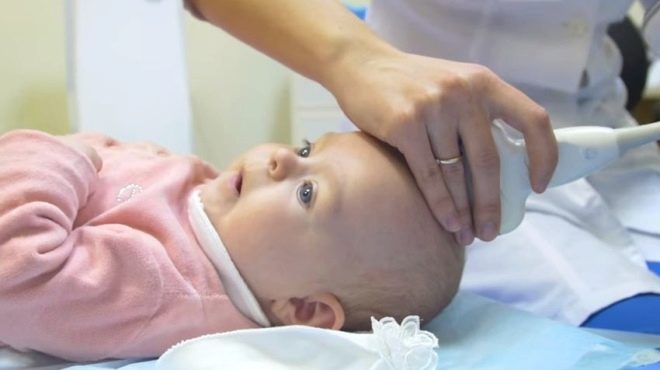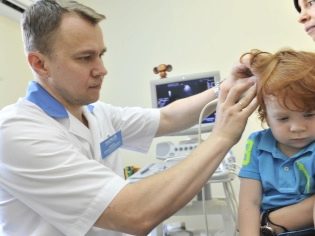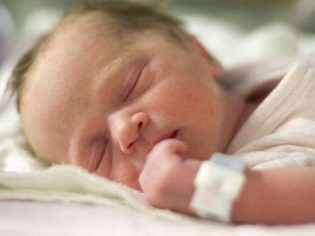What is neurosonography in newborns and infants, how is it performed and what does it show?
The brain is considered one of the most complex and mysterious human organs. The quality of life and the developmental characteristics of the child depend on his condition and health. Therefore, a special control is established behind the brain, which starts from the very birth of the child. The method of neurosonography helps to find out whether the baby’s brain is properly formed and develops normally. How the survey is conducted and what it shows, we will describe in this article.
What it is?
Neurosonography is called ultrasound examination of the brain of babies. In fact, this is an ordinary ultrasound scan, which is well known to everyone, but it is only carried out in the most convenient period, when the spring has not closed in the baby.
The mobility of the bones of the skull is necessary for the baby to ensure the passage of the head through the birth canal of the mother during birth. And for quite a long time, the "springs" remain unclosed. It is this feature that makes it possible to conduct an ultrasound scan of brain structures in search of signs of congenital or acquired ailments.
Usually, the HCL of the brain is carried out to newborns and children under the age of one and a half years, after this age “spring”, as a rule, are closed. After that, some time is possible to study through the temporal lobes, and then information about the state of the brain can only be obtained by electroencephalography (EEG), computed tomography (CT) or MRI.
Neurosonography has been introduced by the Ministry of Health of Russia into the list of comprehensive ultrasound examinations of the first screening, which is performed on infants at 1 month. Earlier and later this period, the examination is carried out in the presence of medical indications, which we describe below.
Is it safe?
Despite a lot of rumors, most of which are generated by parents themselves in numerous forums on the Internet, the study is considered safe and harmless to kids. The essence of what is happening is quite simple, and to understand it does not require deep knowledge in physics: the sensor generates ultrasonic waves of a certain frequency and length, the waves pass through the tissues of the human body perfectly, are reflected from different brain structures differently and, reflected, are sent back. .
The sensor detects the "answer" and forms the image on the monitor of the ultrasonic device. It is this image that the doctor evaluates, but again, not “by eye”, but with the help of special mathematical algorithms included in the scanner software.
Rumors of harm, it is possible, were not born from scratch, because medicine, which uses the ultrasound method for only about 20 years, does not have a sufficient statistical base proving the absence of harm from ultrasound in the future. To collect such information takes significantly more than two decades.
However, there is also no data confirming the harmful effects of ultrasound testing on the children's body. Therefore, the procedure is considered safe. It does not hurt the baby. Opponents of the study should be reminded of the ultrasound during pregnancy, because part of the structure of the brain of the fetus was evaluated through the anterior abdominal wall of a pregnant woman.But the neurosonography of the infant allows for a more complete picture of the structures and functioning of his brain.
If necessary, the baby can be done neurosonography as many times as necessary to establish or clarify the diagnosis until the spring draws out and the bones of the skull begin to become strong.
Technique of
Technically, neurosonography is not much different from any other ultrasound. The baby is located on the diaper, lying on the couch in the supine position. The doctor applies a small amount of acoustic gel to the area of the fontanel to fit the sensor more closely and to better conduct ultrasound waves. Within 7-10 minutes, the sensor moves along the head of the infant, measurements of individual parts of the brain are taken, after which the NSG protocol is issued to parents.
There are NSG with advanced features - with doppler. This study gives an idea not only about the structures, shapes and sizes of areas and brain regions, but also about the blood supply process of this important organ.
Preparation for neurosonography is not required. The only restriction applies to anti-spasmodic drugs and analgesics. Such funds for a couple of days before the examination should not be given to the child, since they affect the size of the vessels.
Mom may well feed the child before the examination, so that the crumb doesn’t worry and has the doctor examine himself. But even if your toddler will be filled with tears during the scan, this will not affect the results: neither the size nor the functions of the brain parts change the behavior of the baby.
Who needs it?
As already mentioned, it is desirable to make NSG for all babies at 1 month or at 3 months, if for some reason a medical examination of a child at four weeks of age was not conducted.
The Council of the Ministry of Health is, of course, advisory in nature, and therefore parents can refuse to be examined, but this is not recommended, because if there are pathologies later, when the spring begins to close, the diagnosis will be difficult.
However, there are categories of babies for whom neurosonography is recommended especially. First of all, these are children who were born prematurely (up to 37 weeks of pregnancy, inclusive). Premature babies are a category of special risk, including the likelihood of development of pathologies from the brain and central nervous system. Experts also consider mandatory the holding of NSG for children, the appearance of which occurred surgically - if the woman was given a cesarean section.
If the following symptoms are found in a child during the first weeks of life, parents also should not abandon neurosonography:
- the child behaves strangely: in the absence of diseases he eats badly, often and abundantly spits, he is inactive, does not show bright emotions, often cries, sleeps superficially, constantly wakes up, if the baby has pronounced tremor of the limbs, chin, there is a squint;
- the baby often cries, throws back the head and arches the back (this may be an indirect sign of increased intracranial pressure);
- the baby does not hear well or reacts weakly to visual stimuli, does not follow the toy’s eyes, cannot focus on the mother’s face;
- low blood pressure in a baby, fainting, cramps;
- pronounced lack of coordination (infant sweeps and flinches have nothing to do with it);
- the child has a birth trauma or he fell, hit his head, there was a sharp tilting of the head after birth.
If a child is scheduled for surgery in the near future vessels or heart, NSG is mandatory.Unplanned neurosonography will be carried out in the event of a fall, because the method allows to establish signs of a concussion, contusion, or the formation of cerebral hematomas.
A child who has had a severe viral infection should also be examined to rule out signs of encephalitis or meningitis. The NSG method is also used in the diagnosis of tumors.
Be sure to examine the children who were born with a low weight (less than 2700 grams), as well as babies who were born with asymmetry (which have one ear below the other, one eye more than the other, etc.)
External anatomical malformations (the presence of extra fingers on the hands and feet, the absence of limbs, etc.) are also a good reason for a careful ultrasound examination of the infant's brain.
Children born after pregnancy, which was accompanied by fetal hypoxia, Rhesus conflict, must undergo an NSG, as the long-term consequences of these unfavorable intrauterine conditions can be quite severe.
Norm indicators
A healthy child is about one year old, and children are older, both hemispheres are symmetrical. It is this indicator that the doctor assesses and describes first. Symmetry breaking can be a sign of both congenital anomalies and the development of a neoplastic process.
In a healthy child, the furrows and gyrus of the medullary cortical layer are well visualized, all structural units, without exception, have clear and even contours. Fluids in the spaces between the right and left hemispheres are not found in a healthy toddler.
Ventricles, tanks have certain dimensions, which correspond to the tables according to which the decoding of indicators takes place. Radiant beams show signs of hyperechogenicity.
The ventricles of the brain, as indicated in the protocol for the study of a healthy baby, have a homogeneous structure, without extraneous inclusions. If Mom and Dad are very interested in the meaning of the numbers in the conclusion, then the normal figures are as follows:
- lateral ventricles - anterior horns - 2 mm (after 3 months - 2-4 mm);
- lateral ventricles-posterior (occipital) horns - 10-15 mm;
- body of lateral ventricles - no more than 4 mm;
- the size of the third ventricle of the brain - 3-5 mm;
- fourth ventricle - no more than 4 mm;
- interhemispheric fissure - 3-4 mm;
- large brain cistern - maximum 10 mm;
- subarachnoid space - an average of 3 mm.
This data is not the ultimate truth. At the medical conclusion, the doctor necessarily takes into account the height and weight of the child, because the small-weight child with miniature forms and the size of the brain may differ in the smaller side.
Pathologies
Refusing to be examined, parents risk not seeing in time, and, therefore, not starting a timely treatment in case of a cyst-like neoplasm. Cysts can be different - some, for example, arachnoid, are quite dangerous for the baby and need to be treated.
The increased volume of cerebral fluid inside the skull may indicate the presence of dropsy of the brain, while darkening and vascular pathologies may indicate ischemia, cerebral palsy, hematomas. The appearance of such terms in the ultrasound protocol is not a diagnosis yet, since additional diagnosis is required for making a diagnosis, neurosonography is not enough.
Quite often, such an examination reveals physiological and functional disorders that do not need any therapy and go on with their own time. They are caused by the neurophysiological immaturity of the brain - a state that is quite natural for newborns.
Some formations have favorable prognoses, but need regular monitoring, and some states, such as hydrocephalus, need therapy as soon as possible.
Do not assume that a child who visually gives the impression of being completely healthy cannot have brain development abnormalities. They are rather insidious and it is almost impossible to see them with the naked eye, unless, of course, the pathologies are total. We say this not to frighten parents, but to think well before abandoning neurosonography, considering it unnecessary and even harmful.
Opinions moms
Having received a referral to NSG, many mothers rush to the Internet for an answer to the question whether such diagnostics are needed at all. And here they may well stumble upon reviews of the near-scientific sense, in which the opponents of ultrasound for the child justify the harm and destructive consequences of neurosonography for the baby. If you have a great desire, you can read such reviews, but we strongly advise against taking them on faith.
Best of all, all questions of interest about the feasibility and possible harm of diagnosis should be asked to your doctor.
There is a category of mothers who do not trust doctors from the district children's clinic. For them, too, there is a way out - to make NSG in a private clinic, although at their own expense - on average in the country, such an ultrasound scan costs from 1,500 to 3,000 thousand rubles.
Mothers who describe the "incredible suffering" of a baby during neurosonography do not take into account that a child is crying in a diagnostic room not from pain, but from fright, because a completely stranger touches him, which, from the point of view of the baby, is a direct threat to him security.
For more information about the neurosonography procedure in newborns and infants, see the following video.


























